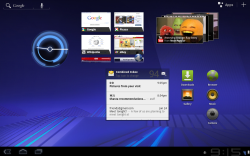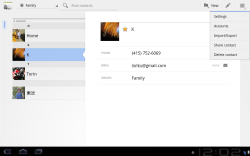Android 3.0 Platform Preview and SDK released

![]() Android 3.0's UI now features a Action Bar and System Bar to make better use of tablet sized displays
Android 3.0's UI now features a Action Bar and System Bar to make better use of tablet sized displays
Source: Google
Google has announced the availability of a preview of the Android 3.0 Platform, code-named "Honeycomb", and updated the SDK tools with an enhanced UI Builder and 3.0 support. The preview of 3.0 contains APIs which are non-final but which will allow developers to become accustomed to the tablet form factor support which has been the focus of 3.0 development.
Among the changes, an almost always visible "System Bar" gives access to notifications, system status and soft versions of the Android navigation buttons, such as home and back. It also gives access to a "Recent Apps" list which allows users to move between running applications. However, the "System Bar" can be removed from the display in a fullscreen "lights out mode". It is complemented by a new "Action Bar" for applications at the top of the screen. This allows developers to offer in-application context sensitive options, widgets, navigation buttons and other information.
A new customisation scheme for up to five home screens allows for widgets, app shortcuts and wallpapers to be laid out more precisely and with better visual cues. All home screens will offer a general application launcher and Google search box which can search apps, contacts, media files and, of course, the web. The on-screen keyboard has been refined to make it easier to use on the larger screen formats of tablets, and keys such as "Tab" have been added. There have also been improvements to the built in applications: the browser now has multiple tabs and an incognito mode, and the email and contacts applications have a two-pane user interface which makes use of the "Action Bar".

![]() The multiple panes in tablet sized Android 3.0 user interfaces can be controlled by Activity fragments
The multiple panes in tablet sized Android 3.0 user interfaces can be controlled by Activity fragments
Source: Google
For developers, the enhancements to Android are extensive. Activity fragments extend the Activity metaphor of Android applications to allow the panes that make up a tablet display to be managed by separate activities, making the creation of complex and rich applications easier. The user interface widgets have been redesigned for larger screens with a new "holographic" theme, and new widgets include a 3D stack, search box, date/time picker, number picker, calendar and popup menu. Notifications have been enhanced to allow for richer content and more control over what is displayed to the user. A new animation framework, hardware accelerated 2D graphics and a platform independent shader as part the 3D graphics engine round out the graphics enhancements. Changes to the Dalvik VM, Bionic library and other system components allow for Android 3.0 to run on single core or multicore systems; in dual core systems, for example, a single threaded application will still be able to benefit from the Dalvik garbage collection running on the other core and this will, say Google, be arranged automatically.
Developers can access a summary of all the new features and functionality. The Preview SDK includes an early 3.0 system image to run on the Android emulator, Android 3.0 libraries with non-final APIs, an emulator skin which gives a WXGA-size display and new documentation for Android 3.0 which details the differences between 2.3 and 3.0. The Preview SDK can be installed by downloading the SDK starter system and from within that can then be installed the SDK platform preview, SDK Tools revision 9, SDK platform tools revision 2, documentation and samples for Honeycomb. Android is, in general, licensed under the Apache licence.
(djwm)
![Kernel Log: Coming in 3.10 (Part 3) [--] Infrastructure](/imgs/43/1/0/4/2/6/7/2/comingin310_4_kicker-4977194bfb0de0d7.png)

![Kernel Log: Coming in 3.10 (Part 3) [--] Infrastructure](/imgs/43/1/0/4/2/3/2/3/comingin310_3_kicker-151cd7b9e9660f05.png)
















